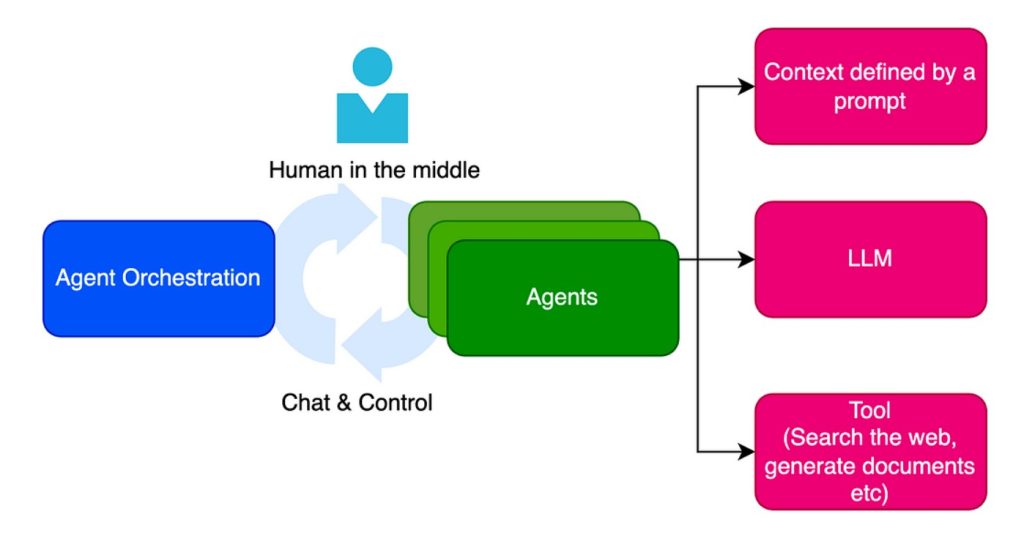
Multi-Agent Orchestrator: Managing and Deploying AI Agent Systems
Multi-agent orchestrators are transforming the way AI systems operate, enabling the seamless management of diverse agents to solve complex problems efficiently. This article explores AI agents, their orchestration frameworks, and leading solutions shaping the future of artificial intelligence.
What is AI Agents?
AI agents are intelligent software programs designed to operate autonomously or semi-autonomously to perform specific tasks or solve problems. They leverage artificial intelligence techniques such as machine learning, reasoning, and natural language processing to interact with their environment and achieve goals.
Core Characteristics of AI Agents:
- Autonomy: Operate without continuous human intervention.
- Adaptability: Learn and improve over time based on experience and data.
- Goal-Oriented: Prioritize tasks to achieve predefined objectives.
- Interactive: Engage with other agents, systems, or humans to complete tasks.
Types of AI Agents:
- Reactive Agents: Respond immediately to environmental stimuli without storing memory.
- Deliberative Agents: Utilize planning and reasoning for decision-making.
- Collaborative Agents: Work together in teams to solve complex problems.
- Learning Agents: Continuously adapt and improve using feedback mechanisms.
Applications of AI Agents:
- Customer Support: Virtual assistants provide real-time answers to queries.
- Healthcare: AI agents assist in diagnostics and patient monitoring.
- Finance: Automated trading and fraud detection systems optimize financial operations.
- Smart Cities: Manage traffic systems, utilities, and urban planning.
AI agents form the backbone of many modern systems, enabling intelligent automation and decision-making across industries.
What is the Use of Multi-Agent Orchestrator Framework?

A Multi-Agent Orchestrator Framework is a system designed to manage and coordinate the operations of multiple AI agents working together. In environments where tasks are too complex or large for a single agent, these frameworks ensure efficient collaboration and execution.
Functions of a Multi-Agent Orchestrator Framework:
- Task Allocation: Breaks down large tasks into smaller subtasks and assigns them to appropriate agents.
- Coordination: Ensures agents communicate effectively and avoid redundant efforts.
- Resource Management: Allocates computational resources based on task priorities.
- Scalability: Allows the addition or removal of agents as needed.
- Monitoring and Reporting: Tracks agent performance and logs activities for debugging and optimization.
Benefits:
- Enhanced efficiency through specialized task management.
- Reduced operational costs by automating multi-agent workflows.
- Improved reliability with built-in monitoring and error-handling capabilities.
Examples of Real-World Applications:
- E-commerce: Coordinating inventory management, pricing algorithms, and personalized recommendations.
- Logistics: Managing warehouse operations, route planning, and delivery tracking.
- Cybersecurity: Detecting and responding to threats in real time.
Multi-agent orchestrator frameworks are indispensable for creating scalable and intelligent AI ecosystems.
List of Top 10 Multi-Agent Orchestrator Frameworks for Deploying AI Agents
- Amazon Bedrock (AWS):
A managed platform for building and deploying AI systems, offering dynamic orchestration and integration with AWS services. - Swarm (OpenAI):
Focused on enabling collaborative problem-solving among generative AI agents. - Bee Agent Framework (IBM):
A modular and enterprise-friendly framework designed for scalability and analytics-driven insights. - Magentic-One Framework (Microsoft):
Integrates seamlessly with Azure to deliver powerful orchestration and resource optimization. - DeepMind Distributed Agent Framework:
Ideal for high-level research, handling distributed multi-agent interactions. - Rasa Multi-Agent Platform:
Specializes in managing conversational AI agents with advanced natural language capabilities. - Google AgentFlow:
Designed for cloud-native multi-agent deployments with a focus on data-driven tasks. - NVIDIA Omniverse:
Offers orchestration for agents in simulated environments, particularly for gaming and virtual reality. - JaCaMo:
A Java-based platform combining programming, organizational, and environmental models for agent collaboration. - AgentOS:
A lightweight system for deploying real-time multi-agent solutions.
These frameworks cater to diverse needs, from research environments to large-scale enterprise applications.
An Introduction to Multi-Agent Orchestrator, Amazon Bedrock by AWS
Amazon Bedrock, a service by AWS, simplifies the orchestration of multi-agent systems by integrating generative AI capabilities with cloud services. It allows businesses to deploy and manage AI agents effectively, leveraging foundation models from leading providers.
Core Features:
- Dynamic Task Management: Automatically assigns and tracks subtasks among agents.
- Integration with AWS Services: Seamless access to tools like Lambda, S3, and SageMaker.
- Scalable Infrastructure: Supports large-scale operations with flexible resource allocation.
- Security and Compliance: Meets enterprise-grade standards for data privacy and reliability.
Applications:
- Customer service optimization through multi-agent chatbots.
- Streamlined workflows in data-intensive industries such as finance and healthcare.
Amazon Bedrock enables organizations to orchestrate AI agents efficiently while maintaining scalability and performance.
An Introduction to Multi-Agent Orchestrator, Swarm by OpenAI
Swarm by OpenAI is an experimental orchestrator framework designed for collaborative generative AI tasks. By fostering interaction between multiple AI agents, Swarm aims to solve complex problems through dynamic cooperation.
Key Features:
- Collaborative Problem Solving: Agents work together to refine and enhance outputs.
- Generative AI Optimization: Focused on tasks like content creation, model building, and research.
- Real-Time Adjustment: Automatically reallocates tasks as agents complete their objectives.
Applications:
- Collaborative writing and content generation.
- Multi-agent systems for AI research and simulation.
Swarm represents a leap in orchestrating generative AI tasks, where creativity and adaptability are paramount.
An Introduction to Multi-Agent Orchestrator, Bee Agent Framework by IBM
The Bee Agent Framework by IBM provides a modular and scalable solution for deploying enterprise-grade AI agents. Its focus on analytics and lifecycle management makes it an ideal choice for large organizations.
Key Features:
- Modular Architecture: Supports customized agents tailored to specific business needs.
- Performance Monitoring: Offers detailed insights into agent efficiency and system health.
- AI Lifecycle Management: Streamlines development, deployment, and maintenance processes.
Applications:
- Optimizing supply chains with predictive analytics.
- Enhancing customer engagement through personalized recommendations.
IBM’s Bee Agent Framework is designed for businesses seeking robust, enterprise-scale AI solutions.
An Introduction to Multi-Agent Orchestrator, Magentic-One Framework by Microsoft
The Magentic-One Framework, developed by Microsoft, focuses on integrating multi-agent systems into cloud environments using the Azure ecosystem. It emphasizes data-driven decision-making and resource efficiency.
Core Features:
- Azure Integration: Leverages Azure’s AI, storage, and analytics tools for optimal performance.
- Task Prioritization: Dynamically manages agent workflows based on real-time requirements.
- Enterprise Security: Ensures data protection with compliance to global standards.
Applications:
- Data analytics for business intelligence.
- Managing large-scale urban systems like traffic and energy distribution.
Microsoft’s Magentic-One Framework showcases the potential of cloud-native orchestration for enhancing multi-agent systems.
Conclusion
Multi-agent orchestrators are at the forefront of AI evolution, enabling complex systems to work seamlessly and achieve goals efficiently. Frameworks like Amazon Bedrock, OpenAI’s Swarm, IBM’s Bee Agent Framework, and Microsoft’s Magentic-One Framework offer diverse tools and capabilities to meet the needs of businesses and researchers alike. By leveraging these advanced systems, organizations can unlock the true potential of AI agents in solving real-world challenges.